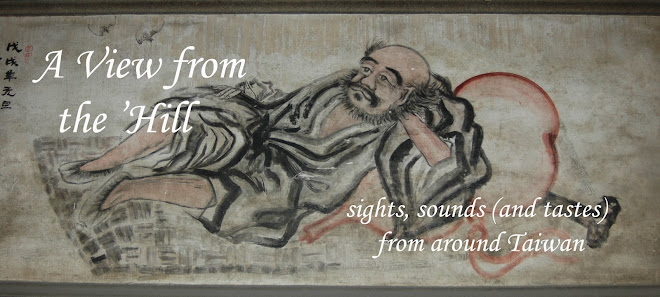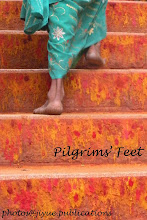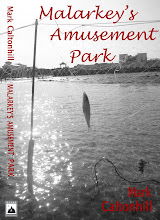TEXT AND PHOTOS BY MARK CALTONHILL
Derived from an aboriginal word Vanka referring to the canoes with which indigenous people brought sweet potatoes, charcoal, and other produce downriver to sell to Chinese settlers, it was adapted as Manga (艋舺; literally “small boat”) in Minnan. These characters meant nothing to the Japanese when they took over Taiwan in 1895, so they used the similarly pronounced Manka (萬華; literally “Ten Thousand Flowers”), and these characters were preserved by the incoming ROC administration from 1945, but using the Mandarin pronunciation Wanhua. Hence none of the original characters, meaning, or pronunciation was preserved.
The river was the heart of this district, the earliest part of Taipei inhabited by Han Chinese, but today is largely hidden behind high levees. A good place to start a visit is at the Taipei City Wholesale Fish Market (531 Wanda Road) near the river, where more than 100 tons of fresh fish are auctioned before dawn each day. Smaller quantities can be bought at the retail stalls next door, and there are a couple of restaurants selling cooked fish. Less bloody, the No.1 Fruit and Vegetable Wholesale Market nearby is also worth a look.
By the 1730s, Manga was the main center of trade in northern Taiwan, the origin of Taipei City, as well as its major port. This dominant role continued until silting of the river led to Manga’s decline. Another perhaps more important cause was the frequent fighting among ethnic subgroups who had migrated from Jinjiang (晉江), Hui’an (惠安), Nan’an (南安) and Tong’an (同安) in Fujian Province. These clashes finally led to a mass exodus of the losers, who then established Dadaocheng (大稻埕) as a rival wharf further downstream (at the end of today’s MinSheng West Road).
Manga’s Qingshui Zushi Temple (清水祖師廟), first built in 1787, was razed during such fighting in 1853, only to be rebuilt in 1867. Largely overshadowed by its larger neighbor Longshan Temple (龍山寺), its sleepy, restaurant-sided courtyard offers a glimpse of times gone by. It would probably not look very different from when Canadian George MacKay first came in 1872. One of the most successful missionaries in the entire China region, he nevertheless had great difficulty “taking” Manga. In his book From Far Formosa, MacKay spells it as Bang-kah, nicknames it “the Gibraltar of heathenism in North Formosa,” and says that its estimated population of around 45,000 made it the largest and most important city in northern Taiwan.
“The citizens of Bang-kah, old and young, are daily toiling for money, money – cash, cash,” he noted in his journal of 1875. “They are materialistic, superstitious dollar-seekers. At every visit, when passing through their streets we are maligned, jeered at, and abused. Hundreds of children run ahead, yelling with derisive shouts; others follow, pelting us with orange-peel, mud, and rotten eggs. For hatred to foreigners, for pride, swaggering ignorance, and conceit, for superstitious, sensual, haughty, double-faced wickedness, Bang-kah takes the palm.”
Today foreigners are warmly welcomed, though even the main tourist sights (Longshan Temple, Snake Alley, Xinmending, etc.) are not overrun with outsiders and the atmosphere is thoroughly local. Longshan, for example, is a typical working temple, where Manga residents go to supplicate and thank their favorite deities. Ostensibly a Buddhist place of worship, since the main deity worshiped is the Bodhisattva Guanyin, in reality it is typical of mixed temples with numerous other figures honored in smaller shrines to the rear.
Ghost money and herbs
XiYuan Road on the temple’s west side has many stores specializing in religious paraphernalia. Selling everyday items such as ghost money, divination tools, and statues, as well as high art and more bizarre items such as weapons used by jitong (乩童; “divination boys”) for self-harm when possessed by spirits, they are good places for visitors to search for more unusual souvenirs.
Along the east side of the temple is “herb lane,” worth exploring for vegetation used in cooking and herbal cures.
In front of Longhsan Temple is a large open plaza. This is an ideal place to learn about traditional life in contemporary Taipei. Members of the local community, most of them elderly males, gather here all day long to pass the time, make friends, and enjoy themselves, and the side streets are filled with small cheap eateries. One store of unusual interest is the secondhand bookshop, antique bazaar, and café at No. 152, Lane 4, GuangZhou Street, one of the nearest things Manga has to a museum.
Another museum-like venture is the government-backed development of Bopiliao (剝皮寮), a short street of old buildings, one block further east near the junction of GuangZhou Street and KangDing Road. Still a work in progress, it already throngs with local sightseers because it was featured in Niu’s Monga. With official support, many of the small houses along what is said to have been the district’s main street in very early times have been renovated and contain exhibitions of history, art, and local culture. Although there is not yet much in the way of English information, it is still a good place to take pictures and buy souvenirs.
Back on the square, buskers entertain crowds, experts pick lottery numbers for hopeful gamblers, people dance and play Chinese chess, monks beg, and streetwalkers and their pimps approach potential customers.
Although prostitution has officially been stopped, it seems to be tolerated in Manga, where the predominantly elderly women operate openly and there are still STD clinics behind the temple. The showcase platform of this “colorful” slice of local culture, HuaXi Street (華西街; nicknamed “Snake Alley”) further east, which had open displays of snakes, turtles, and apes, and one of the city’s major red-light districts along adjacent alleys, has largely been cleaned up. This is probably due to tourist dollars as much as government edict: the sanitized market now specializes in seafood snacks and foot massages as much as snake blood and happy endings. There are many temples in the district, and many temple activities. Of particular note is that each year in November or December (the 22nd and 23rd days of the 10th lunar month), the Qingshan Temple (青山宮) at 218 GuiYang Street Sec. 2 organizes one of Taipei’s most spectacular street parades, with statues of deities from nearby temples brought to celebrate the King of Qingshan’s birthday. Beyond the bright lights and camera crews, this is also an event that will have changed little since MacKay’s time.
Uniforms and costumes
From a transportation hub based on the river, Manga developed into a center of trade. In addition to the fishing and agricultural products sold in its markets, it was particularly known for its textile and clothing businesses. While these have largely gone elsewhere (mainly to China and Southeast Asia), there are still a few reminders to be seen and enjoyed. Two curiosities in the otherwise quiet Hanzhong Street area are the trade outfitters and fancy dress shops. The former provide uniforms for everyone from shop staff to marching bands, while the latter stock costumes for private parties, trade shows, and cosplay events.
Far more obvious is the modish district of Ximending, Taiwan’s first pedestrian zone. Busy on weekday evenings, it is completely mobbed with young people on weekends, when record companies, cosmetic manufacturers, and others put on stage shows featuring established and up-and-coming music and television stars. Licensed buskers and street artists draw crowds in the wider car-free streets, while the back alleys leading toward KunMing Street are home to dozens of small independent designers selling clothing and accessories to Taipei’s counterculture youths. There are tattoo artists and body piercers as well as hair salons, manicurists, and masseurs. Street walls are covered in bright murals and graffiti, and the sound of skateboards echoes through the lanes above the chords of indie-music played on portable hifis.
The area is also popular with musicians making pop videos, and with local television and film makers. Of course, Niu was not the first mainstream director to make use of the area’s traditional atmosphere. Hou Hsiao-hsien also chose it for his 1986 film Dust in the Wind (戀戀風塵) and Tsai Ming-liang used it in his 1992 Rebels of the Neon God (青少年哪吒).
Manga was once the entertainment center of Taipei, with numerous theaters doing good business on weekdays and weekends alike. Although many are gone, largely replaced by KTV centers, Ximending still has a range of movie houses showing mainstream and art movies, and is one of the main centers of activity during the annual Taipei International Film Festival.
One reversal of this cultural decline was the reopening of the Red House Theater (紅樓劇場) in 2002. This fine Japanese-era, Western-style building dating from 1908 was originally constructed as a market, but was converted to a theater by Shanghai émigrés in 1949. Now under city government control, it has handicraft stalls on the first floor, but regularly organizes performances upstairs.
Its reconstruction led to a wider change in local fortunes, and the pedestrian zone around the theater fills with café tables by day and pub seating at night. This is a center of Taipei’s LGBT (Lesbian, gay, bisexual, and transgender) community, as can be identified by the leather trouser and underwear specialist stores – Manga’s latest take on the textile industry – interspersed among the cafés.
The rest of Manga, lying to the south of the now underground Taipei-to-Banqiao railway line, has its own attractions, but is largely residential. For locals, two of the highlights of living there are the spacious Youth Park and even more massive Riverside Park beneath the Huazhong Bridge to Yonghe.
Wanhua Railway Station offers access to the Longshan Temple area for visitors from outside the capital, though Taipei Main Station is within walking distance of Ximending. There are also MRT stations at Longshan Temple and Ximending, and ZhongHua Road is a main hub for bus services throughout the city and beyond.
Out-of-towners can also take advantage of the wide choice of hotels in the neighborhood, ranging from backstreet hovels to high-class establishments. Perhaps the ideal location for those wishing to connect with Manga’s past is one of the riverside hotels with windows offering views of the sunset across the waters that once swarmed with boats.
So what will you find in Manga? No guns, hopefully, though perhaps a few hints of gangs, and definitely a lady-of-the-night or two. And religion to be sure, food for certain, and maybe you will even fall in love with Taipei’s original conurbation.
Text and photos copyright Taiwan Business Topics and Jiyue Publications 2011/2012






No comments:
Post a Comment